Authentic 'Spanish Carrillada' Recipe
Thursday, April 25, 2024
Embark on a culinary journey to the heart of Spain with this sumptuous Carrillada en Salsa - beef cheeks in sauce, a celebration of flavours guaranteed to impress at any gathering. This dish, steeped in tradition, is a sensory marvel renowned for its rich aroma and deep flavours. Although beef cheeks aren't a cut you might find every day at your local butcher, a little planning and a request can ensure you have this succulent meat ready for your culinary exploration.
Known for their transformation into a tender, melt-in-your-mouth delight upon slow cooking, beef cheeks are a fabulous option for a family meal that's out of the ordinary. Carrillada, or cheeks, is a cut that requires slow cooking, transforming it into a tender, decadent dish. This recipe employs beef cheek for its marbling, rendering the meat exceptionally succulent. However, pork cheeks can also be used with a slightly shorter cooking time, for those desiring an equally flavourful alternative.
.png)
Ingredients for 4 people:
-
For the Carrillada:
-
2-3 Beef cheeks - approximately 1,2kg, cleaned of any membranes
-
Salt, to taste
-
Freshly ground black pepper, to taste
-
50g (approx. ½ cup) all-purpose flour, for dusting
-
30ml (2 tablespoons) olive oil
-
For the Sauce:
-
2 onions, coarsely chopped
-
3 cloves garlic, quartered
-
1 carrot, peeled and sliced into thick rounds
-
1 green bell pepper, cut into strips
-
3-4 sprigs of thyme
-
1 ripe tomato, grated
-
300ml red wine
-
1 litre beef broth
-
For the Fried Potatoes:
-
500g potatoes, peeled and cubed
-
Extra Virgin Olive oil, for frying
-
Salt, to taste
Instructions:
-
Prepare the Beef Cheeks:
-
Season the beef cheeks with salt and pepper on both sides.
-
Dust them lightly in flour.
-
In a large pot, heat the olive oil over medium heat and brown the beef cheeks on both sides. Remove and set aside.
-
Make the Vegetable Sofrito:
-
In the same pot, add the onions, garlic, carrot, green pepper, and thyme. Cook over low heat until they start to soften and take on some colour.
-
Stir in the grated tomato and cook for another 10 minutes to reduce the tomato's water content.
-
Cook the Beef Cheeks:
-
Return the browned beef cheeks to the pot.
-
Pour in the red wine, increasing the heat to reduce the alcohol for about 5 minutes.
-
Add the beef broth, cover, and simmer over medium-low heat for 1 hour and 30 minutes, or until very tender.
-
Prepare the Sauce:
-
Once the cheeks are tender, remove them from the pot.
-
Blend the sauce until smooth, then strain for a silkier texture. Return both the sauce and cheeks to the pot, simmering for an additional 5 minutes to allow the flavours to combine.
-
Fry the Potatoes:
-
While the cheeks are simmering, fry the potatoes. Heat a generous amount of olive oil in a deep pan.
-
First, cook the potatoes over medium heat until soft inside. Remove them and then increase the heat in order to get a golden and crispy coating. Return the chips to the oil and crisp them up.
-
Season with salt immediately after removing them from the oil.
-
Serve:
.png)
This Carrillada en Salsa offers a taste of traditional Spanish cuisine, perfect for those special occasions or a heartwarming family dinner. It's a dish that celebrates the simplicity of ingredients and the love of slow cooking, promising a succulent feast that leaves a lasting impression.
Pair this dish with a glass of robust red wine for an authentic Spanish dining experience that transports you straight to the vibrant heart of Spain, one bite at a time.
 1
Like
Published at 7:33 PM Comments (0)
1
Like
Published at 7:33 PM Comments (0)
Sea Bass Cooked in Salt - Spanish Style
Friday, April 19, 2024
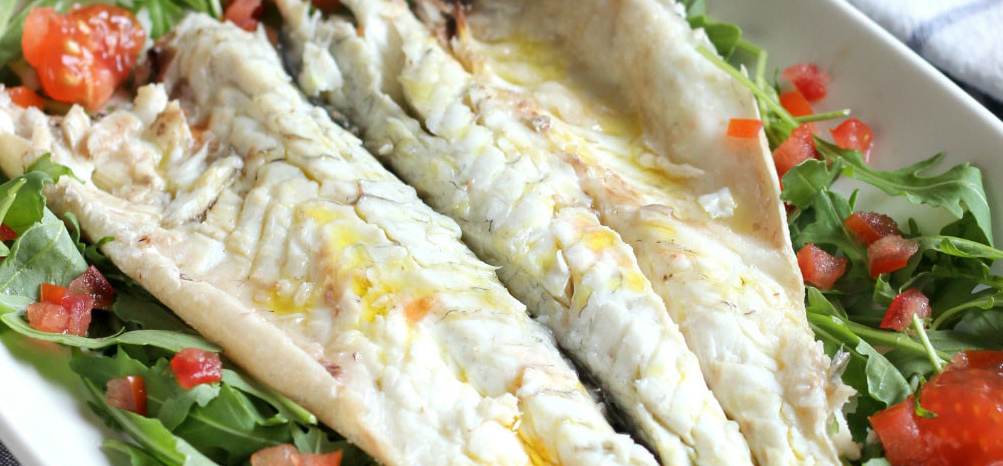
For those who read my blog regularly, will know that I don't often post fish recipes, seafood is quite common, but fish? Let's say it's not one of my favourite foods. That said, it doesn't mean I don't know how to cook fish...something I had to get to grips with because my wife happens to love fish, so now and again I will eat it or just cook it!
If you were following my blog, in the past you will have read my recipe for "Pollo a la Sal"- Chicken in Salt - well that recipe really originated from this one and as I happened to cook it again recently, I thought I might share it with you.
Cooking sea bass, or any other fish as it happens, in salt produces a rock-hard shell around the fish thus keeping in heat and flavour. It is an extremely old cooking technique believed to have originated from the Dead Sea region and then it extended throughout the Mediterranean. Fishermen would lay the fish on a large stone and cover it with rock salt then they would light a fire beneath the stone, the rising heat would get trapped in the salt 'oven' so to speak and cook the fish evenly. Fortunately, no rocks are needed for this recipe! The technique, although old, is extremely effective and there are many reasons to keep using it and experimenting with different foods.
Despite what you might think, covering the fish with salt does not make the food salty. Being rock salt and bound with egg, it never penetrates the food and simply acts as a made-to-measure oven wall. Because the hard salt shell prevents any moisture from escaping during the cooking process it keeps the meat moist and tender.
The fish effectively cooks in its own juices whilst inside the shell, it does not require any fat or oil. The result is a really healthy fish meal - low in calories and high in nutrients. The egg binder makes the salt wall practically airtight keeping in all the flavour, be it from the meat or fish itself or the added herbs and seasoning - Nothing escapes
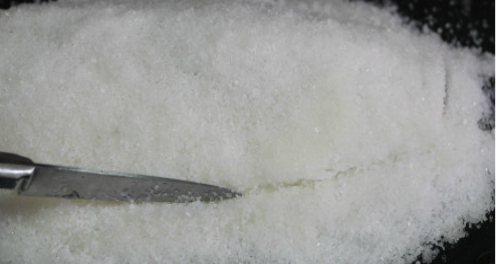 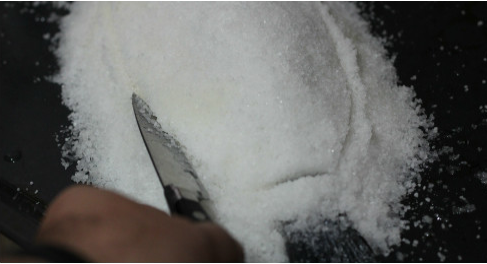
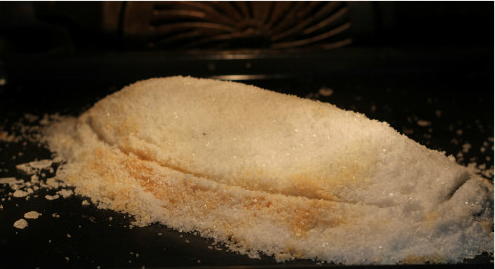 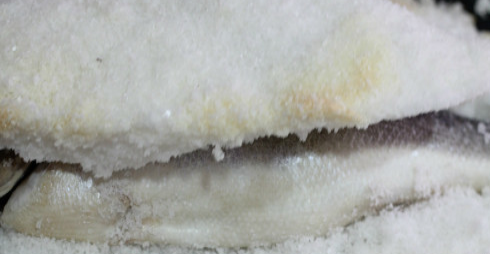
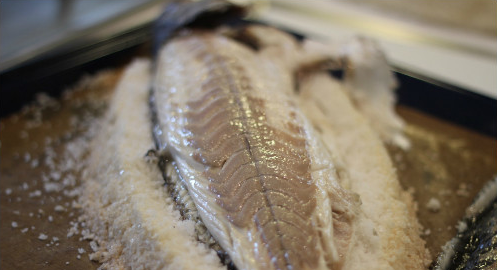
Ingredients for two people:
800 g Seabass – gutted BUT with the scales left on (if you can't find one big one, get two small ones and lay them side by side)
1.5 kg of Coarse sea salt
2 Egg whites
1 tbsp Ground Fennel
Steps:
- Preheat your oven to 200ºC.
- In a big bowl, use your hands and mix the salt, the fennel and the egg whites.
- Get an oven tray big enough to place the sea bass on. Lay down a 1 cm-thick layer of salt, covering the entire bottom of the tray or an area more than big enough to sit the seabass on. Remember to avoid scaling the fish as the scales protect the fish from the heat.
- Place the sea bass on top and cover it completely with salt except for the tail, which should remain uncovered. This is a little trick to test if the fish is cooked properly. Make sure you pat the salt down until it becomes firm and compact, then mark a line following the silhouette of the fish without penetrating the salt completely. This will help when you break it open after cooking. #See photos above#
- Bake in the oven for 18 minutes at 200ºC. Avoid opening the oven during this time.
- Remove from the oven. Pull the fishtail and if it comes away easily the fish is ready, if it is doesn't, it needs a little longer.
- Use a sharp knife and cut along the line previously marked out before cooking and take off the salt cap in one piece if possible.
- Remove the fish skin with care and use a couple of spoons to fillet the fish. Then remove the bones, in one piece, and finally remove the second fillet. It is important not to remove the fish whole from the salt as it will just fall to pieces.
- Drizzle with some parsley oil and serve warm together with some salad or grilled vegetables.
Enjoy!
 0
Like
Published at 10:18 PM Comments (3)
0
Like
Published at 10:18 PM Comments (3)
Spam post or Abuse? Please let us know
|
|